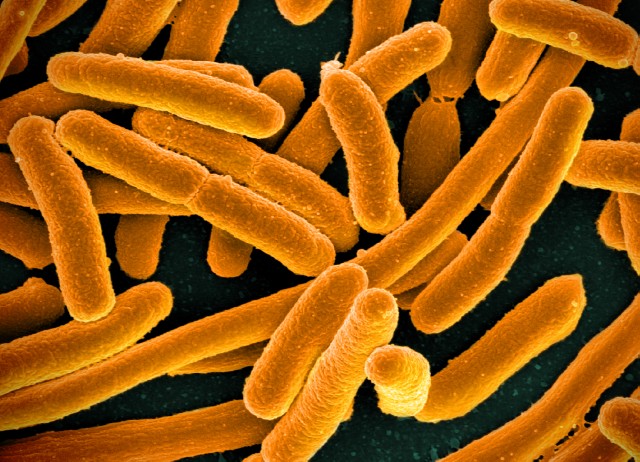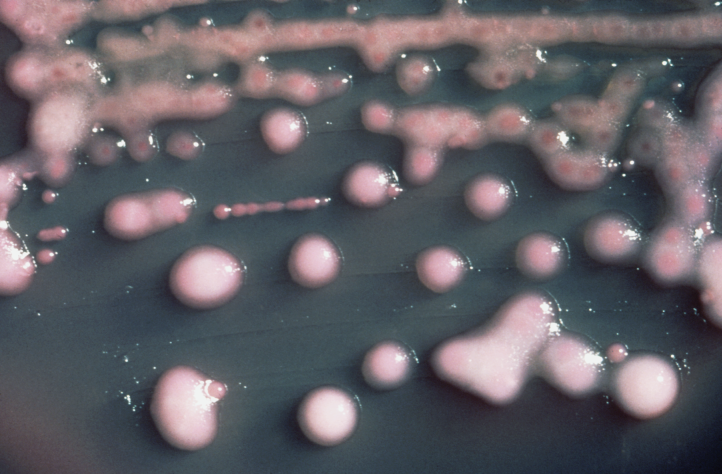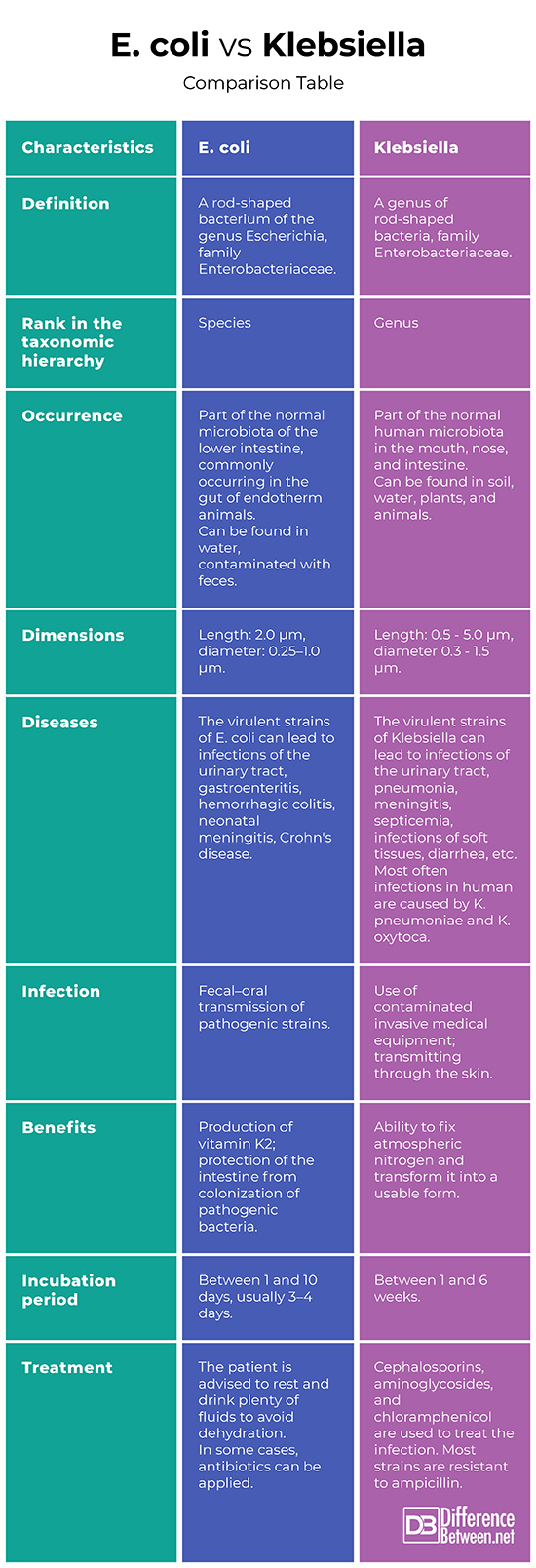Difference Between E. Coli and Klebsiella
What is E. Coli?
Escherichia coli is a rod-shaped bacterium of the genus Escherichia, family Enterobacteriaceae. It is facultatively anaerobic, chemoheterotrophic, Gram-negative, nonsporulating species. It is part of the normal microbiota of the lower intestine commonly occurs in the gut of endotherm species.
The length of E. coli is about 2.0 μm, its diameter is 0.25–1.0 μm.
Most of the strains of the species are harmless, but there are serotypes which can lead to serious health problems.
Typically E. coli colonizes the gastrointestinal tract of a baby in the first 40 hours of its life. It comes with water, food, or from the individuals taking care of the child. When E. coli reaches the large intestine it adheres to the mucus.
The harmless strains of E. coli provide benefits to the hosts. They produce vitamin K2 and protect the intestine from colonization of pathogenic bacteria.
E. coli is released into the environment within the feces. In fresh fecal matter, it grows rapidly for 3 days and afterward the numbers slowly decline.
The fecal–oral transmission of pathogenic strains is the main cause of diseases related to E. coli.
The virulent strains of E. coli can lead to infections of the urinary tract, gastroenteritis, hemorrhagic colitis, neonatal meningitis, Crohn’s disease. The symptoms of infection with a virulent strain include diarrhea, abdominal cramps, vomiting, hemorrhagic colitis, fever. Virulent strains can cause bowel necrosis and perforation, mastitis, peritonitis, septicemia, and pneumonia. Virulent E. coli can affect healthy individuals of all ages, but most vulnerable are the young children.
The incubation period is between 1 and 10 days, usually 3–4 days. Usually, the infection goes by itself. The patient is advised to rest and drink plenty of fluids to avoid dehydration. In some cases, antibiotics can be applied to shorten the course of the disease, however, this is generally not recommended due to the increasing resistance to commonly used antibiotics.
Some nonpathogenic strains of E. coli are used in the medicine, as probiotic agents, to treat different gastroenterological diseases.
What is Klebsiella?
Klebsiella is a genus of rod-shaped, facultatively anaerobic, non-motile bacteria from Enterobacteriaceae family. They are oxidase-negative, Gram-negative, and have a prominent polysaccharide-based capsule. Klebsiella species are widespread and can be found in soil, water, plants, and animals. Some species are associative nitrogen fixers.
Klebsiella is a part of the normal human microbiota in the mouth, nose, and intestines.
In general, the Klebsiella species are thicker and shorter, compared to other representatives of the Enterobacteriaceae family. Their diameter is between 0.3 and 1.5 µm and their length – 0.5 to 5.0 µm. They occur in chains, in pairs, or singly.
Klebsiella species are part of the normal human microbiota. However, they can behave as opportunistic pathogens.
Klebsiella can lead to infections of the urinary tract, pneumonia, meningitis, septicemia, infections of soft tissues, diarrhea, etc. Most often infections in human are caused by K. pneumoniae and K. oxytoca.
Most susceptible to Klebsiella infections are children, elderly people and people with underlying diseases.
Most of the Klebsiella infections are a result of the use of contaminated invasive medical equipment. The bacteria can be transmitted through the skin after contact with contaminated objects.
The incubation period of Klebsiella is between 1 and 6 weeks.
Multiple drug resistance is characteristic for Klebsiella. Cephalosporins, aminoglycosides, and chloramphenicol are used to treat the infection. Most strains are resistant to ampicillin.
Klebsiella is a useful bacterium for the plants, due to its ability to fix atmospheric nitrogen and transform it into a usable form.
Difference Between E. coli and Klebsiella
-
Definition of E. coli vs. Klebsiella
E. coli: Escherichia coli is a rod-shaped bacterium of the genus Escherichia, family Enterobacteriaceae.
Klebsiella: Klebsiella is a genus of rod-shaped bacteria, family Enterobacteriaceae.
-
Rank in the taxonomic hierarchy
E. coli: E. coli is a species.
Klebsiella: Klebsiella is a genus.
-
Occurrence
E. coli: It is part of the normal microbiota of the lower intestine and commonly occurs in the gut of endotherm organisms. It can be found in water, contaminated with feces.
Klebsiella: Klebsiella species are widespread and can be found in soil, water, plants, and animals. It is a part of the normal human microbiota in the mouth, nose, and intestines.
-
Dimensions
E. coli: The length of E. coli is about 2.0 μm, its diameter is 0.25–1.0 μm.
Klebsiella: The length of Klebsiella is between 0.5 and 5.0 µm, its diameter is between 0.3 and 1.5 µm.
-
Diseases from E. coli vs. Klebsiella
E. coli: The virulent strains of E. coli can lead to infections of the urinary tract, gastroenteritis, hemorrhagic colitis, neonatal meningitis, Crohn’s disease.
Klebsiella: The virulent strains of Klebsiella can lead to infections of the urinary tract, pneumonia, meningitis, septicemia, infections of soft tissues, diarrhea, etc. Most often infections in human are caused by K. pneumoniae and K. oxytoca.
-
Infection
E. coli: The fecal–oral transmission of pathogenic strains is the main cause of diseases related to E. coli.
Klebsiella: Most of the Klebsiella infections are a result of the use of contaminated invasive medical equipment. The bacteria can be transmitted through the skin after contact with contaminated objects.
-
Benefits
E. coli: The harmless strains of E. coli provide benefits to the hosts. They produce vitamin K2 and protect the intestine from colonization of pathogenic bacteria. Some strains are used as probiotic agents, to treat different gastroenterological diseases.
Klebsiella: Klebsiella is a useful bacterium for the plants, due to its ability to fix atmospheric nitrogen and transform it into a usable form.
-
Incubation period
E. coli: The incubation period of E. coli is between 1 and 10 days, usually 3–4 days.
Klebsiella: The incubation period of Klebsiella is between 1 and 6 weeks.
-
Treatment for E. coli and Klebsiella
E. coli: The patient is advised to rest and drink plenty of fluids to avoid dehydration. In some cases, antibiotics can be applied to shorten the course of the disease.
Klebsiella: Multiple drug resistance is characteristic for Klebsiella. Cephalosporins, aminoglycosides, and chloramphenicol are used to treat the infection. Most strains are resistant to ampicillin.
E. coli verses Klebsiella: Comparison Table
Summary of E. coli vs. Klebsiella:
- Escherichia coli is a rod-shaped bacterium of the genus Escherichia, family Enterobacteriaceae.
- Klebsiella is a genus of rod-shaped bacteria, family Enterobacteriaceae.
- E. coli is a species, while Klebsiella is a genus.
- E. coli is part of the normal microbiota of the lower intestine and commonly occurs in the gut of endotherm animals. It can be found in water, contaminated with feces. Klebsiella species are widespread and can be found in soil, water, plants, and animals. They are part of the normal human microbiota in the mouth, nose, and intestines.
- The length of E. coli is about 2.0 μm, its diameter is 0.25–1.0 μm. The length of Klebsiella is between 0.5 and 5.0 µm, its diameter is between 0.3 and 1.5 µm.
- The virulent strains of E. coli can lead to infections of the urinary tract, gastroenteritis, hemorrhagic colitis, neonatal meningitis, Crohn’s disease. The virulent strains of Klebsiella can lead to infections of the urinary tract, pneumonia, meningitis, septicemia, infections of soft tissues, diarrhea, etc.
- The fecal–oral transmission of pathogenic strains is the main cause of diseases related to E. coli. Most of the Klebsiella infections are a result of the use of contaminated invasive medical equipment.
- The harmless strains of E. coli produce vitamin K2 and protect the intestine from colonization of pathogenic bacteria. Klebsiella is a useful bacterium for the plants, due to its ability to fix atmospheric nitrogen and transform it into a usable form.
- The incubation period of E. coli is between 1 and 10 days, usually 3–4 days. The incubation period of Klebsiella is between 1 and 6 weeks.
- The treatment of E. coli includes rest, drinking plenty of fluids to avoid dehydration, and in some cases – antibiotics. Cephalosporins, aminoglycosides, and chloramphenicol are used to treat Klebsiella infections.
- Difference Between Gallstones and Cholecystitis - September 5, 2021
- Difference Between Constipation and Cramping - August 4, 2021
- Difference Between Whole Genome Sequencing and Microarray - May 6, 2021
Search DifferenceBetween.net :
Leave a Response
References :
[0]Image credit: https://commons.wikimedia.org/wiki/File:Klebsiella_pneumoniae_01.png
[1]Image credit: https://commons.wikimedia.org/wiki/File:E._coli_Bacteria_(16598492368).jpg
[2]Dube, H. Textbook of Fungi, Bacteria and Viruses. Mumbai: Promilla Publisher. 2007. Print.
[3]Leboffe, M., B E. Pierce. Microbiology: Laboratory Theory and Application. Denver: Morton Publishing Company.2015. Print.
[4]Schuller, M., T. Sloots, G. James, C. Halliday, I. Carter (Eds.). PCR for Clinical Microbiology. New York: Springer. 2010. Print.



